 Technology peripherals
Technology peripherals
 AI
AI
 All-round open source with no dead ends, Xingbo team's LLM360 makes large models truly transparent
All-round open source with no dead ends, Xingbo team's LLM360 makes large models truly transparent
All-round open source with no dead ends, Xingbo team's LLM360 makes large models truly transparent
Open source models are showing their vigorous vitality, not only the number is increasing, but the performance is getting better and better. Turing Award winner Yann LeCun also lamented: "Open source artificial intelligence models are on the road to surpassing proprietary models."
Proprietary models are in technical performance and innovation It shows great potential in terms of capabilities, but due to its non-open source characteristics, it hinders the development of LLM. Although some open source models provide practitioners and researchers with diverse choices, most only disclose the final model weights or inference code, and an increasing number of technical reports limit their scope to top-level design and surface statistics. . This closed-source strategy not only limits the development of open-source models, but also hinders the progress of the entire LLM research field to a great extent. This means that these models need to be more comprehensive and Share in depth, including training data, algorithm details, implementation challenges, and performance evaluation details.
Researchers from Cerebras, Petuum and MBZUAI jointly proposed LLM360. This is a comprehensive open source LLM initiative that advocates providing the community with everything related to LLM training, including training code and data, model checkpoints, and intermediate results. The goal of LLM360 is to make the LLM training process transparent and reproducible for everyone, thereby promoting the development of open and collaborative artificial intelligence research.
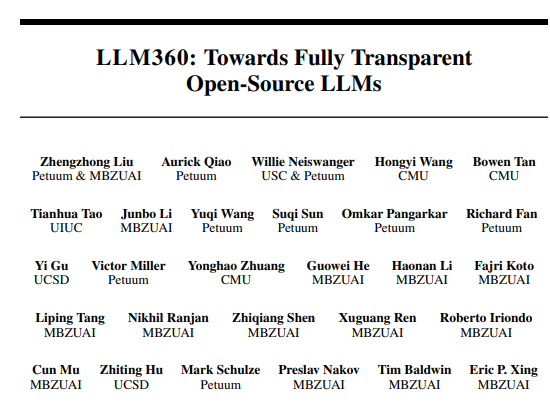
- Project web page: https://www.llm360.ai/
- Blog: https://www.llm360.ai/blog/introducing-llm360-fully-transparent-open-source-llms.html
- Researcher We developed the architecture of LLM360, focusing on its design principles and the rationale for being fully open source. They specify the components of the LLM360 framework, including specific details such as datasets, code and configuration, model checkpoints, metrics, and more. LLM360 sets an example of transparency for current and future open source models.
Researchers released two large-scale language models pre-trained from scratch under the open source framework of LLM360: AMBER and CRYSTALCODER. AMBER is a 7B English language model pre-trained based on 1.3T tokens. CRYSTALCODER is a 7B English and code language model pre-trained based on 1.4T tokens. In this article, the researchers summarize the development details, preliminary evaluation results, observations, and experiences and lessons learned from these two models. Notably, at the time of release, AMBER and CRYSTALCODER saved 360 and 143 model checkpoints during training, respectively.
 Now, let’s take a look at the details of the article
Now, let’s take a look at the details of the article
## The framework of #LLM360
LLM360 will provide a standard for what data and codes need to be collected during the LLM pre-training process to ensure that existing work can be better circulated and shared in the community . It mainly contains the following parts:
1. Training data set and data processing code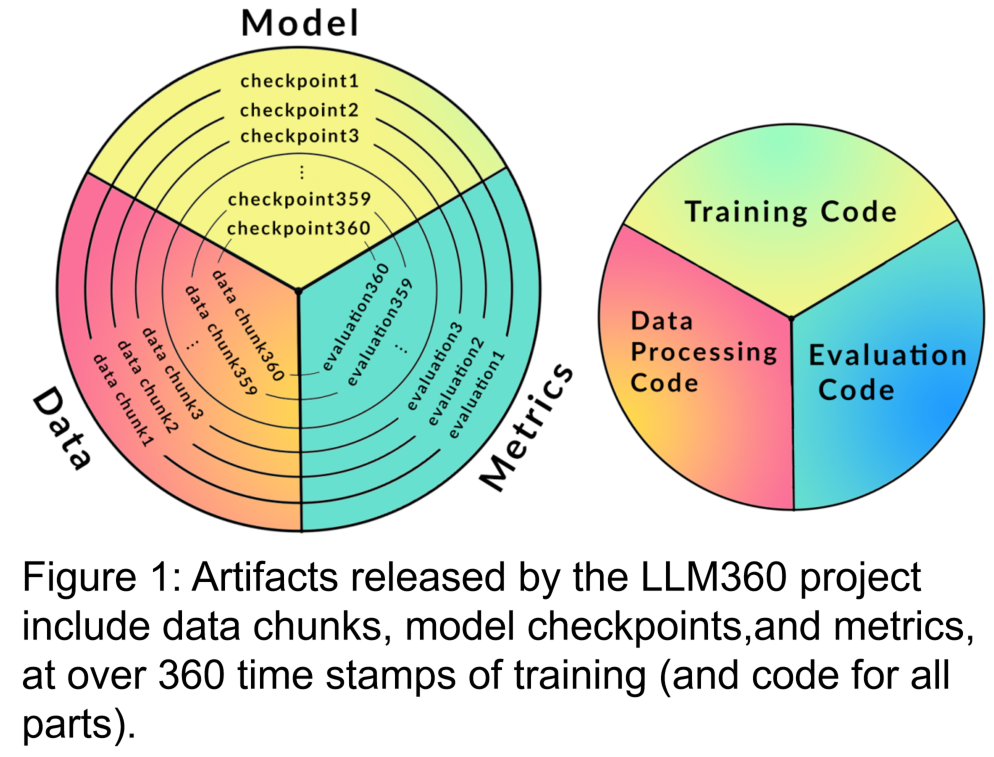
Pre-training datasets are critical to the performance of large language models. Therefore, it is important to understand the pre-training data set to assess potential behavioral issues and biases. Additionally, publicly available pre-training datasets help improve LLM’s scalability when subsequently fine-tuned and adapted to various domains. Recent research shows that training on repeated data disproportionately reduces the final performance of the model. Therefore, exposing the original pre-training data helps avoid using duplicate data when fine-tuning downstream or continuing to pre-train in a specific domain. Based on the above reasons, LLM360 advocates the disclosure of raw data sets of large language models. Where appropriate, details about data filtering, processing, and training sequences should also be disclosed.
The content that needs to be rewritten is: 2. Training code, hyperparameters and configuration
Training code, hyperparameters, and configuration have a significant impact on the performance and quality of LLM training, but are not always publicly disclosed. In LLM360, researchers open source all the training code, training parameters and system configuration of the pre-training framework.
3. Model checkpoint is rewritten as: 3. Model checkpoint
Regularly saved model checkpoints are also Quite useful. Not only are they critical for failure recovery during training, but they are also useful for post-training research. These checkpoints allow subsequent researchers to continue training the model from multiple starting points without having to train from scratch, aiding in reproducibility. and in-depth research.
4. Performance indicators
Training an LLM often takes weeks to months , the evolutionary trends during training can provide valuable information. However, detailed logs and intermediate metrics of training are currently only available to those who have experienced them, which hinders comprehensive research on LLM. These statistics often contain key insights that are difficult to detect. Even a simple analysis such as variance calculations on these measures can reveal important findings. For example, the GLM research team proposed a gradient shrinkage algorithm that effectively handles loss spikes and NaN losses by analyzing the gradient specification behavior.
Amber
AMBER is the first member of the LLM360 "family". Also released are its fine-tuned versions: AMBERCHAT and AMBERSAFE.

What needs to be rewritten: details of data and model
Table 2 details AMBER’s pre-training data set, which contains 1.26 T markers. These include data preprocessing methods, formats, data mixing ratios, as well as architectural details and specific pretraining hyperparameters of the AMBER model. For detailed information, please refer to the project homepage of the LLM360 code base

##AMBER adopts the same model structure as LLaMA 7B4, Table 3 The detailed structural configuration of LLM is summarized. Training hyperparameters. AMBER is trained using the AdamW optimizer, and the hyperparameters are: β₁=0.9, β₂=0.95. In addition, researchers have released several fine-tuned versions of AMBER: AMBERCHAT and AMBERSAFE. AMBERCHAT is fine-tuned based on WizardLM's instruction training data set. For more parameter details, please refer to the original text
In order to achieve the purpose of not changing the original meaning, the content needs to be rewritten into Chinese. The following is a rewrite of "Experiments and Results":
Conduct experiments and result analysis
#The researchers used four benchmark data sets on the Open LLM rankings to evaluate the performance of AMBER. As shown in Figure 4, in the HellaSwag and ARC data sets, the AMBER score gradually increases during the pre-training period, while in the TruthfulQA data set, the score decreases as training proceeds. In the MMLU dataset, the score of AMBER decreases in the initial stage of pre-training and then starts to increase
in Table 4 , the researchers compared the model performance of AMBER with models trained in similar time periods such as OpenLLaMA, RedPajama-INCITE, Falcon, and MPT. Many models are inspired by LLaMA. It can be found that AMBER scores better on MMLU but performs slightly worse on ARC. AMBER's performance is relatively strong compared to other similar models.
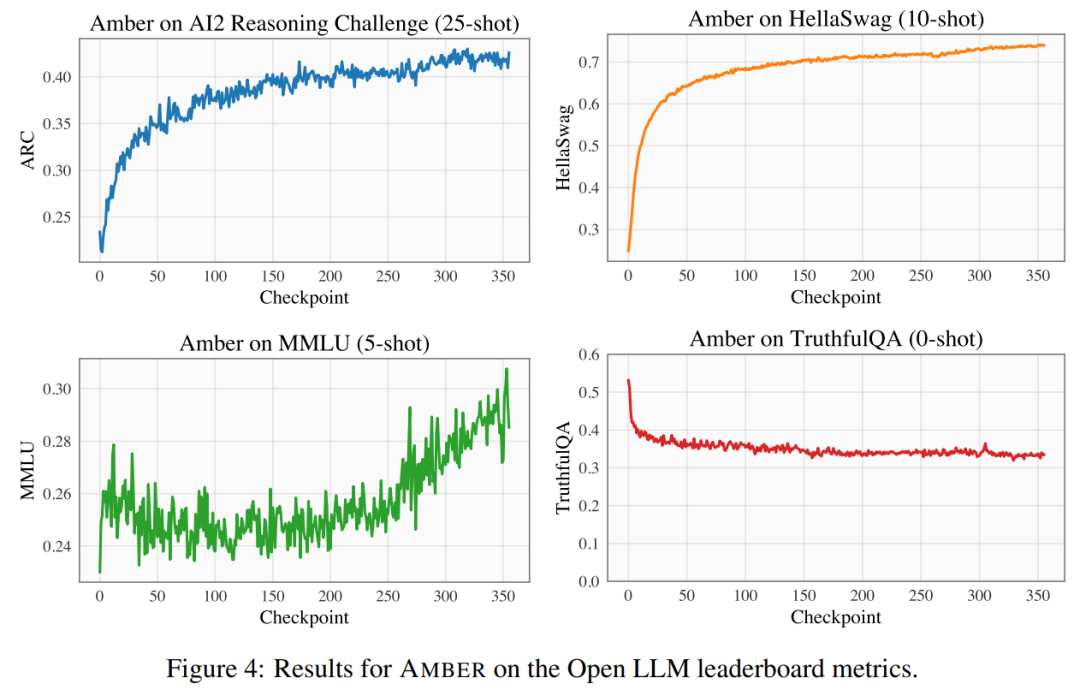
CRYSTALCODER
The second member of LLM360 "Big Family" is CrystalCoder. 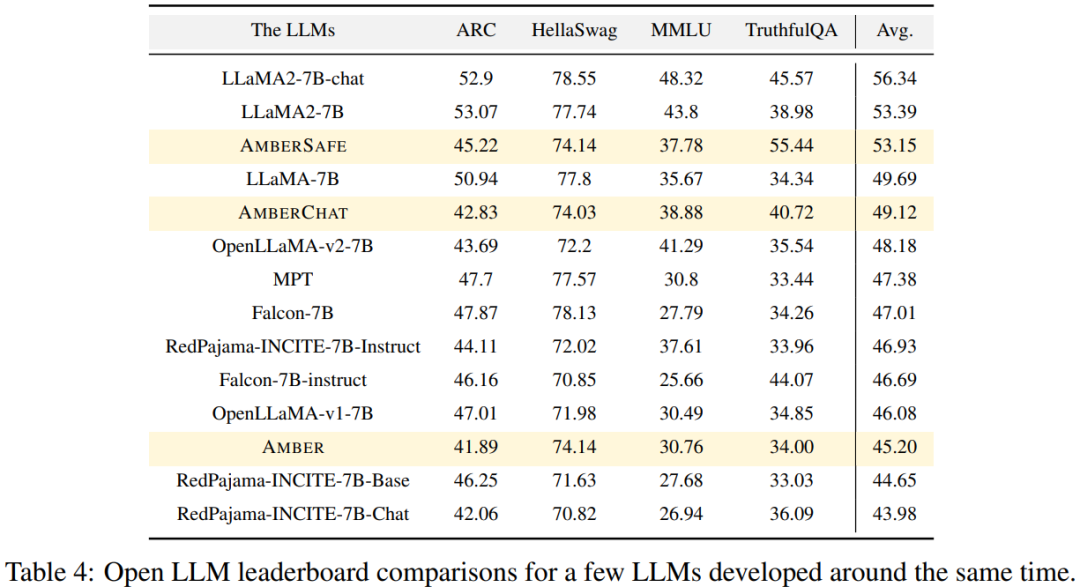
CrystalCoder is a 7B language model trained on 1.4 T tokens, achieving a balance between coding and language capabilities. Unlike most previous code LLMs, CrystalCoder is trained on a careful mixture of text and code data to maximize utility in both domains. Compared with Code Llama 2, CrystalCoder's code data is introduced earlier in the pre-training process. In addition, the researchers trained CrystalCoder on Python and web programming languages to improve its usefulness as a programming assistant.
Rebuild the model architecture
CrystalCoder adopts a very similar architecture to LLaMA 7B, adding the maximum update parameter Chemistry (muP). In addition to this specific parameterization, the researchers also made some modifications. In addition, the researchers also used LayerNorm instead of RMSNorm because the CG-1 architecture supports efficient calculation of LayerNorm.
#In order to achieve the purpose of not changing the original meaning, the content needs to be rewritten into Chinese. The following is a rewrite of "Experiments and Results": Conduct experiments and result analysis
#On the Open LLM Leaderboard, the researcher conducted a benchmark test on the model, including four benchmark data sets and a coding benchmark data set. As shown in Figure 6

Referring to Table 5, you can see that CrystalCoder has achieved a good balance between language tasks and code tasks
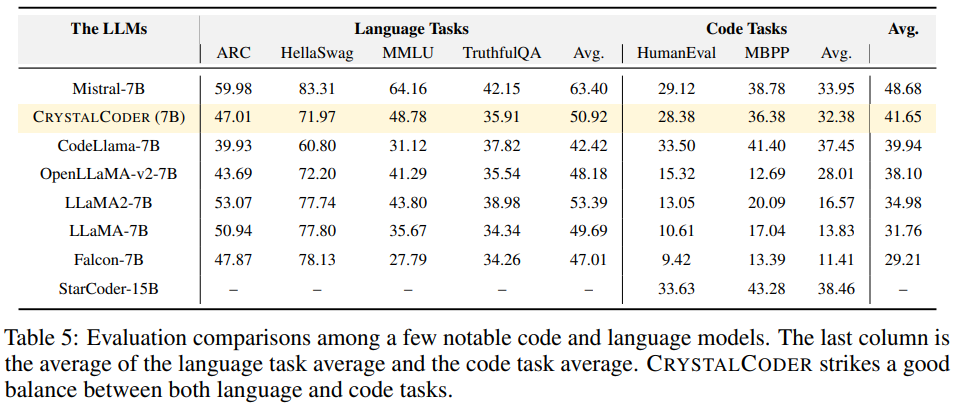
ANALYSIS360
Based on previous research, in-depth research can be carried out by analyzing the intermediate checkpoints of the model. Researchers hope LLM360 will provide the community with a useful reference and research resource. To this end, they released the initial version of the ANALYSIS360 project, an organized repository of multifaceted analyzes of model behavior, including model characteristics and downstream evaluation results
as a An example of analyzing a series of model checkpoints. The researchers conducted a preliminary study on memoization in LLM. Recent research has shown that LLMs may memorize large portions of training data and that this data can be retrieved with appropriate prompts. Not only does this memoization have problems with leaking private training data, but it can also degrade LLM performance if the training data contains repetitions or specificities. The researchers made all checkpoints and data public so that a comprehensive analysis of memorization throughout the training phase can be performed.
The following is the memorization score method used in this article, which is expressed in length The accuracy of the prompt of k followed by the token of length l. For specific memory score settings, please refer to the original article.

The distribution of memorized scores for 10 selected checkpoints is presented in Figure 7

The researchers grouped the data blocks according to the selected checkpoints and plotted each data block for each checkpoint in Figure 8 Memoized score of the group. They found that AMBER checkpoints memorize the latest data better than the previous data. Furthermore, for each data block, the memoization score decreases slightly after additional training, but then continues to increase.
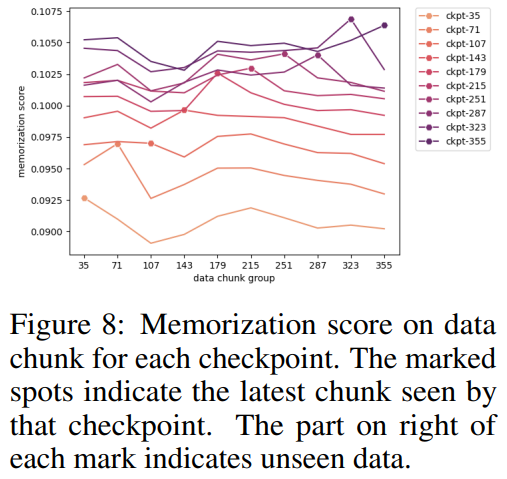
Figure 9 shows the correlation between sequences in memoization scores and extractable k values. It can be seen that there is a strong correlation between checkpoints.
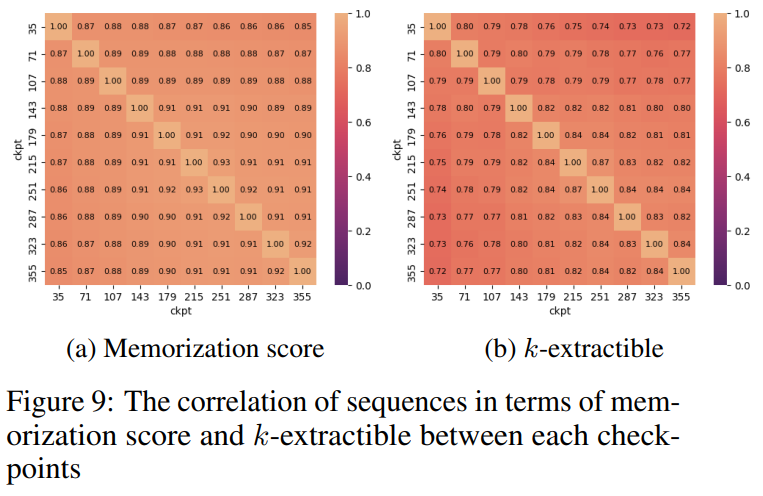
Summary
The researcher summarized the observations and some implications of AMBER and CRYSTALCODER. They say pre-training is a computationally intensive task that many academic labs or small institutions cannot afford. They hope that LLM360 can provide comprehensive knowledge and let users understand what happens during LLM pre-training without having to do it themselves
Please see the original text for more details
The above is the detailed content of All-round open source with no dead ends, Xingbo team's LLM360 makes large models truly transparent. For more information, please follow other related articles on the PHP Chinese website!

Hot AI Tools

Undresser.AI Undress
AI-powered app for creating realistic nude photos

AI Clothes Remover
Online AI tool for removing clothes from photos.

Undress AI Tool
Undress images for free

Clothoff.io
AI clothes remover

AI Hentai Generator
Generate AI Hentai for free.

Hot Article

Hot Tools

Notepad++7.3.1
Easy-to-use and free code editor

SublimeText3 Chinese version
Chinese version, very easy to use

Zend Studio 13.0.1
Powerful PHP integrated development environment

Dreamweaver CS6
Visual web development tools

SublimeText3 Mac version
God-level code editing software (SublimeText3)

Hot Topics
 1378
1378
 52
52
 How to set the Debian Apache log level
Apr 13, 2025 am 08:33 AM
How to set the Debian Apache log level
Apr 13, 2025 am 08:33 AM
This article describes how to adjust the logging level of the ApacheWeb server in the Debian system. By modifying the configuration file, you can control the verbose level of log information recorded by Apache. Method 1: Modify the main configuration file to locate the configuration file: The configuration file of Apache2.x is usually located in the /etc/apache2/ directory. The file name may be apache2.conf or httpd.conf, depending on your installation method. Edit configuration file: Open configuration file with root permissions using a text editor (such as nano): sudonano/etc/apache2/apache2.conf
 How to optimize the performance of debian readdir
Apr 13, 2025 am 08:48 AM
How to optimize the performance of debian readdir
Apr 13, 2025 am 08:48 AM
In Debian systems, readdir system calls are used to read directory contents. If its performance is not good, try the following optimization strategy: Simplify the number of directory files: Split large directories into multiple small directories as much as possible, reducing the number of items processed per readdir call. Enable directory content caching: build a cache mechanism, update the cache regularly or when directory content changes, and reduce frequent calls to readdir. Memory caches (such as Memcached or Redis) or local caches (such as files or databases) can be considered. Adopt efficient data structure: If you implement directory traversal by yourself, select more efficient data structures (such as hash tables instead of linear search) to store and access directory information
 How to implement file sorting by debian readdir
Apr 13, 2025 am 09:06 AM
How to implement file sorting by debian readdir
Apr 13, 2025 am 09:06 AM
In Debian systems, the readdir function is used to read directory contents, but the order in which it returns is not predefined. To sort files in a directory, you need to read all files first, and then sort them using the qsort function. The following code demonstrates how to sort directory files using readdir and qsort in Debian system: #include#include#include#include#include//Custom comparison function, used for qsortintcompare(constvoid*a,constvoid*b){returnstrcmp(*(
 Debian mail server firewall configuration tips
Apr 13, 2025 am 11:42 AM
Debian mail server firewall configuration tips
Apr 13, 2025 am 11:42 AM
Configuring a Debian mail server's firewall is an important step in ensuring server security. The following are several commonly used firewall configuration methods, including the use of iptables and firewalld. Use iptables to configure firewall to install iptables (if not already installed): sudoapt-getupdatesudoapt-getinstalliptablesView current iptables rules: sudoiptables-L configuration
 Debian mail server SSL certificate installation method
Apr 13, 2025 am 11:39 AM
Debian mail server SSL certificate installation method
Apr 13, 2025 am 11:39 AM
The steps to install an SSL certificate on the Debian mail server are as follows: 1. Install the OpenSSL toolkit First, make sure that the OpenSSL toolkit is already installed on your system. If not installed, you can use the following command to install: sudoapt-getupdatesudoapt-getinstallopenssl2. Generate private key and certificate request Next, use OpenSSL to generate a 2048-bit RSA private key and a certificate request (CSR): openss
 How debian readdir integrates with other tools
Apr 13, 2025 am 09:42 AM
How debian readdir integrates with other tools
Apr 13, 2025 am 09:42 AM
The readdir function in the Debian system is a system call used to read directory contents and is often used in C programming. This article will explain how to integrate readdir with other tools to enhance its functionality. Method 1: Combining C language program and pipeline First, write a C program to call the readdir function and output the result: #include#include#include#includeintmain(intargc,char*argv[]){DIR*dir;structdirent*entry;if(argc!=2){
 How Debian OpenSSL prevents man-in-the-middle attacks
Apr 13, 2025 am 10:30 AM
How Debian OpenSSL prevents man-in-the-middle attacks
Apr 13, 2025 am 10:30 AM
In Debian systems, OpenSSL is an important library for encryption, decryption and certificate management. To prevent a man-in-the-middle attack (MITM), the following measures can be taken: Use HTTPS: Ensure that all network requests use the HTTPS protocol instead of HTTP. HTTPS uses TLS (Transport Layer Security Protocol) to encrypt communication data to ensure that the data is not stolen or tampered during transmission. Verify server certificate: Manually verify the server certificate on the client to ensure it is trustworthy. The server can be manually verified through the delegate method of URLSession
 How to do Debian Hadoop log management
Apr 13, 2025 am 10:45 AM
How to do Debian Hadoop log management
Apr 13, 2025 am 10:45 AM
Managing Hadoop logs on Debian, you can follow the following steps and best practices: Log Aggregation Enable log aggregation: Set yarn.log-aggregation-enable to true in the yarn-site.xml file to enable log aggregation. Configure log retention policy: Set yarn.log-aggregation.retain-seconds to define the retention time of the log, such as 172800 seconds (2 days). Specify log storage path: via yarn.n



